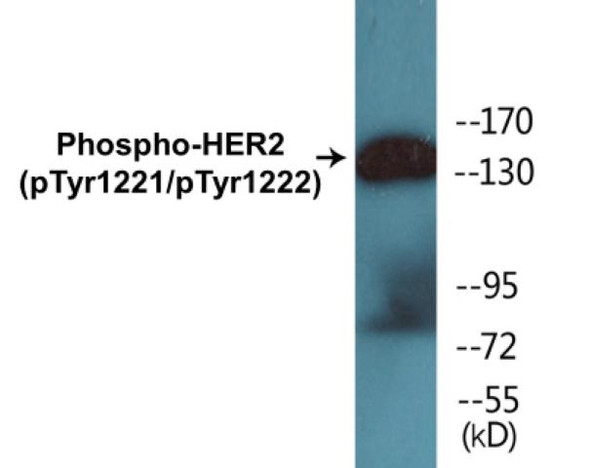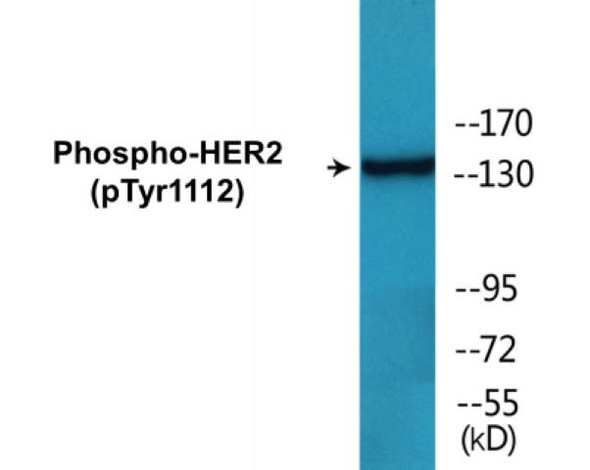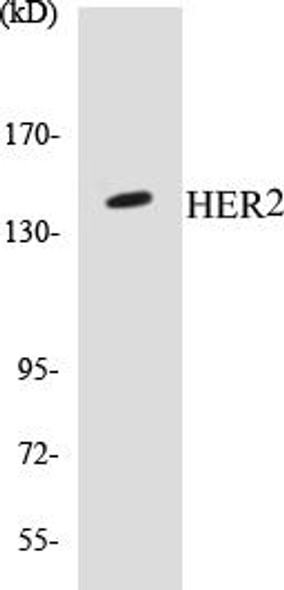HER2 (Phospho-Tyr1248) Fluorometric Cell-Based ELISA Kit
- SKU:
- FBCAB00069
- Product Type:
- ELISA Kit
- ELISA Type:
- Cell Based Phospho Specific
- Reactivity:
- Human
- Mouse
- Rat
- Detection Method:
- Fluorometric
Description
HER2 (Phospho-Tyr1248) Cell-Based ELISA Kit
The HER2 (Phospho-Tyr1248) Cell-Based ELISA Kit is a convenient, lysate- free, high throughput and sensitive assay kit that can monitor HER2 phosphorylation and expression profile in cells. The kit can be used for measuring the relative amounts of phosphorylated HER2 in cultured cells as well as screening for the effects that various treatments, inhibitors (ie. siRNA or chemicals), or activators have on HER2 phosphorylation.
How does our HER2 (Phospho-Tyr1248) Fluorometric Cell-Based ELISA Kit work?
Qualitative determination of HER2 (Phospho-Tyr1248) concentration is achieved by an indirect ELISA format. In essence, HER2 (Phospho-Tyr1248) is captured by HER2 (Phospho-Tyr1248)-specific primary (1°) antibodies while Dye 1-conjugated and Dye 2-conjugated secondary (2°) antibodies bind the Fc region of the 1° antibody. Through this binding, the dye conjugated to the 2° antibody can emit light at a certain wavelength given proper excitation, hence allowing for a fluorometric detection method. Due to the qualitative nature of the Cell-Based ELISA, multiple normalization methods are needed:
| 1. | A monoclonal antibody specific for human GAPDH is included to serve as an internal positive control in normalizing the target RFU values. |
| 2. | An antibody against the nonphosphorylated counterpart of HER2 (Phospho-Tyr1248) is also provided for normalization purposes. The RFU values obtained for non-phosphorylated HER2 can be used to normalize the RFU value for phosphorylated HER2. |
HER2 (Phospho-Tyr1248) Fluorometric Cell-Based ELISA Kit -Information
| Product Name: | HER2 (Phospho-Tyr1248) Fluorometric Cell-Based ELISA Kit |
| Product Code/SKU: | FBCAB00069 |
| Description: | The HER2 (Phospho-Tyr1248) Fluorometric Cell-Based Phospho ELISA Kit is a convenient, lysate-free, high throughput and sensitive assay kit that can monitor HER2 (Phospho-Tyr1248) protein phosphorylation and expression profile in cells. The kit can be used for measuring the relative amounts of phosphorylated HER2 (Phospho-Tyr1248) in cultured cells as well as screening for the effects that various treatments, inhibitors (ie. siRNA or chemicals, or activators have on ERBB2 phosphorylation. |
| Dynamic Range: | > 5000 Cells |
| Detection Method: | Fluorometric |
| Storage/Stability: | 4°C/6 Months |
| Reactivity: | Human, Mouse, Rat |
| Assay Type: | Cell-Based ELISA |
| Database Links: | Gene ID: 2064, UniProt ID: P04626, OMIM #: 164870, Unigene #: Hs.446352 |
| Format: | Two 96-Well Plates |
| NCBI Gene Symbol: | ERBB2 |
| Sub Type: | Phospho |
| Target Name: | Phospho-HER2 (Tyr1248) |
Kit Principle
Figure: Schematic representation of Assay Genie Cell-Based Fluorometric ELISA principle
Kit components | Quantity |
| 96-Well Black Cell CultureClear-Bottom Microplate | 2 plates |
| 10X TBS | 24 ml |
| Quenching Buffer | 24 ml |
| Blocking Buffer | 50 ml |
| 15X Wash Buffer | 50 ml |
| Primary Antibody Diluent | 12 ml |
| 100x Anti-Phospho Target Antibody | 60 µl |
| 100x Anti-Target Antibody | 60 µl |
| Anti-GAPDH Antibody | 110 µl |
| Dye-1 Conjugated Anti-Rabbit IgG Antibody | 6 ml |
| Dye-2 Conjugated Anti-Mouse IgG Antibody | 6 ml |
| Adhesive Plate Seals | 2 seals |
Additional equipment and materials required
The following materials and/or equipment are NOT provided in this kit but are necessary to successfully conduct the experiment:
- Fluorescent plate reader with two channels at Ex/Em: 651/667 and 495/521
- Micropipettes capable of measuring volumes from 1 µl to 1 ml
- Deionized or sterile water (ddH2O)
- 37% formaldehyde (Sigma Cat# F-8775) or formaldehyde from other sources
- Squirt bottle, manifold dispenser, multichannel pipette reservoir or automated microplate washer
- Graph paper or computer software capable of generating or displaying logarithmic functions
- Absorbent papers or vacuum aspirator
- Test tubes or microfuge tubes capable of storing ≥1 ml
- Poly-L-Lysine (Sigma Cat# P4832 for suspension cells)
- Orbital shaker (optional)
Kit Protocol
This is a summarized version of the kit protocol. Please view the technical manual of this kit for information on sample preparation, reagent preparation and plate lay out.
| 1. | Seed 200 µl of desired cell concentration in culture medium into each well of the 96-well plates. For suspension cells and loosely attached cells, coat the plates with 100 µl of 10 µg/ml Poly-L-Lysine (not included) to each well of a 96-well plate for 30 minutes at 37°C prior to adding cells. |
| 2. | Incubate the cells for overnight at 37°C, 5% CO2. |
| 3. | Treat the cells as desired. |
| 4. | Remove the cell culture medium and rinse with 200 µl of 1x TBS, twice. |
| 5. | Fix the cells by incubating with 100 µl of Fixing Solution for 20 minutes at room temperature. The 4% formaldehyde is used for adherent cells and 8% formaldehyde is used for suspension cells and loosely attached cells. |
| 6. | Remove the Fixing Solution and wash the plate 3 times with 200 µl 1x Wash Buffer for 3 minutes. The plate can be stored at 4°C for a week. |
| 7. | Add 100 µl of Quenching Buffer and incubate for 20 minutes at room temperature. |
| 8. | Wash the plate 3 times with 1x Wash Buffer for 3 minutes each time. |
| 9. | Dispense 200 µl of Blocking Buffer and incubate for 1 hour at room temperature. |
| 10. | Wash 3 times with 200 µl of 1x Wash Buffer for 3 minutes each time. |
| 11. | Add 50 µl of Primary Antibody Mixture P to corresponding wells for HER2 (Phospho-Tyr1248) detection. Add 50 µl of Primary Antibody Mixture NP to the corresponding wells for total HER2 detection. Cover the plate with parafilm and incubate for 16 hours (overnight) at 4°C. If the target expression is known to be high, incubate for 2 hours at room temperature. |
| 12. | Wash 3 times with 200 µl of 1x Wash Buffer for 3 minutes each time. |
| 13. | Add 50 ul of Secondary Antibody Mixture to corresponding wells and incubate for 1.5 hours at room temperature in the dark. |
| 14. | Wash 3 times with 200 µl of 1x Wash Buffer for 3 minutes each time. |
| 15. | Read the plate(s) at Ex/Em: 651/667 (Dye 1) and 495/521 (Dye 2). Shield plates from direct light exposure. |
| 16. | Wash 3 times with 200 µl of 1x Wash Buffer for 5 minutes each time. |
HER2 (Phospho-Tyr1248) - Protein Information
| UniProt Protein Function: | HER2: a proto-oncogenic receptor tyrosine kinase of the EGFR family. Essential component of a neuregulin-receptor complex, although neuregulins do not interact with it alone. Not activated by EGF, TGF- alpha and amphiregulin. Amplified in breast cancer. Overexpression induces constitutive activity, and the gene is amplified or overexpressed in up to 30% of breast cancers, correlating with poor survival. The antibody Herceptin is approved for treatment of metastatic breast cancer with HER2 amplification/overexpression. Somatic mutations seen in 4% of lung cancers and also in breast, gastric, ovarian cancer and glioblastoma. One SNP shows predisposition to breast and gastric cancer. Inhibitors: Herceptin, lapatinib, PKI-166, EKB-569, CI-1033. |
| UniProt Protein Details: | Protein type:EC 2.7.10.1; EGFR family; Kinase, protein; Membrane protein, integral; Oncoprotein; Protein kinase, TK; Protein kinase, tyrosine (receptor); TK group Chromosomal Location of Human Ortholog: 17q12 Cellular Component: basolateral plasma membrane; cytoplasm; endosome membrane; nucleus; plasma membrane; receptor complex Molecular Function:ErbB-3 class receptor binding; growth factor binding; identical protein binding; phosphatidylinositol-4,5-bisphosphate 3-kinase activity; protein binding; protein C-terminus binding; protein heterodimerization activity; protein phosphatase binding; protein-tyrosine kinase activity; Ras guanyl-nucleotide exchange factor activity; transmembrane receptor activity; transmembrane receptor protein tyrosine kinase activity Biological Process: cell proliferation; cell surface receptor linked signal transduction; enzyme linked receptor protein signaling pathway; MAPKKK cascade; phosphoinositide 3-kinase cascade; phosphoinositide-mediated signaling; positive regulation of cell adhesion; positive regulation of cell growth; positive regulation of epithelial cell proliferation; positive regulation of GTPase activity; positive regulation of MAP kinase activity; positive regulation of protein amino acid phosphorylation; positive regulation of transcription from RNA polymerase I promoter; positive regulation of transcription from RNA polymerase III promoter; positive regulation of translation; protein amino acid autophosphorylation; protein amino acid phosphorylation; regulation of microtubule-based process; regulation of phosphoinositide 3-kinase cascade; signal transduction; transmembrane receptor protein tyrosine kinase signaling pathway; wound healing Disease: Gastric Cancer; Glioma Susceptibility 1; Lung Cancer |
| NCBI Summary: | This gene encodes a member of the epidermal growth factor (EGF) receptor family of receptor tyrosine kinases. This protein has no ligand binding domain of its own and therefore cannot bind growth factors. However, it does bind tightly to other ligand-bound EGF receptor family members to form a heterodimer, stabilizing ligand binding and enhancing kinase-mediated activation of downstream signalling pathways, such as those involving mitogen-activated protein kinase and phosphatidylinositol-3 kinase. Allelic variations at amino acid positions 654 and 655 of isoform a (positions 624 and 625 of isoform b) have been reported, with the most common allele, Ile654/Ile655, shown here. Amplification and/or overexpression of this gene has been reported in numerous cancers, including breast and ovarian tumors. Alternative splicing results in several additional transcript variants, some encoding different isoforms and others that have not been fully characterized. [provided by RefSeq, Jul 2008] |
| UniProt Code: | P04626 |
| NCBI GenInfo Identifier: | 119533 |
| NCBI Gene ID: | 2064 |
| NCBI Accession: | P04626.1 |
| UniProt Secondary Accession: | P04626,Q14256, Q6LDV1, Q9UMK4, B2RZG3, B4DHN3, X5D2V5 |
| UniProt Related Accession: | P04626 |
| Molecular Weight: | 97,382 Da |
| NCBI Full Name: | Receptor tyrosine-protein kinase erbB-2 |
| NCBI Synonym Full Names: | erb-b2 receptor tyrosine kinase 2 |
| NCBI Official Symbol: | ERBB2 |
| NCBI Official Synonym Symbols: | NEU; NGL; HER2; TKR1; CD340; HER-2; MLN 19; HER-2/neu |
| NCBI Protein Information: | receptor tyrosine-protein kinase erbB-2 |
| UniProt Protein Name: | Receptor tyrosine-protein kinase erbB-2 |
| UniProt Synonym Protein Names: | Metastatic lymph node gene 19 protein; MLN 19; Proto-oncogene Neu; Proto-oncogene c-ErbB-2; Tyrosine kinase-type cell surface receptor HER2; p185erbB2; CD_antigen: CD340 |
| UniProt Gene Name: | ERBB2 |







